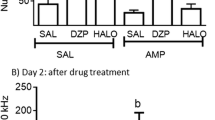Abstract
Three recently arrived drug naive Cebus apella monkeys with “spontaneous” stereotyped oral movements were treated with apomorphine and haloperidol using a wide dose range. Low doses of apomorphine (0.05–0.1 mg/kg) suppressed the oral stereotypies without affecting normal behaviour such as grooming and scratching. Higher doses of apomorphine (0.25–1.0 mg/kg) and haloperidol (0.01–0.1 mg/kg) also decreased or abolished the oral stereotypies, but induced generalized stereotypies (apomorphine) or dystonia/parkinsonism (haloperidol), suppressing normal behaviour. The findings indicate that dopamine is involved in these presumably stress-induced (not drug-induced) stereotypies.
Similar content being viewed by others
References
Antelman SM, Eichler AJ, Black CA, Kocan D (1980) Interchangeability of stress and amphetamine in sensitization. Science 207:329–331
Bjørndal N, Gerlach J, Casey DE, Christensson E (1983) Effect of apomorphine and GABAergic drugs in monkeys pretreated with haloperidol. Psychopharmacology 79:220–225
Bleuler E (1911) Dementia praecox oder Gruppe der Schizophrenien. Franz Dcuticke, Leipzig und Wien, p 392
Casey DE (1981) Responses to dopamine agonists before, during and after neuroleptic treatment in nonhuman primates. In: Jansson B, Perris C, Struwe G (eds) Biological psychiatry 1981, development in psychiatry, vol. 5. Elsevier/North Holland Biomedical Press, Amsterdam, pp 833–836
Clark D, Carlsson A, Hjorth S, Svensson K, Engel J, Sanchez D (1982) Is 3-PPP a potential antipsychotic agent? Evidence from animal behavioural studies. Eur J Pharmacol 83:131–134
Eibergen RD, Carlson KR (1976) Dyskinesias in monkeys: Interaction of metamphetamine with prior methadone treatment. Pharmacol Biochem Behav 5:175–187
Ferrier IN, Johnstone EC, Crow TJ (1984) Clinical effects of apomorphine in schizophrenia. Br J Psychiatry 144:341–348
Feser A (1875) Ampomorphinum hydrochloratum, ein Heilmittel gegen die sogenannte Lecksucht der Rinder, Schafe und Schweine. Z Prakt Veterinärwissenschaft 65:111–113
Fog R (1972) On stereotypy and catalepsy: Studies on the effect of amphetamines and neuroleptics in rats. Munksgaard, Copenhagen
Fray PJ, Sahakian BJ, Robbins TW, Koob GF, Iversen SD (1980) An observational method for quantifying the behavioural effects of dopamine agonists: Contrasting effects of d-amphetamine and apomorphine. Psychopharmacology 69:253–259
Kiley-Worthington M (1977) Behavioural problems of farm animals. Oriel Press, London
Kraepelin E (1913) Psychiatrie, achte Auflage. Verlag von Johann Ambiosius Barth, Leipzig, pp 775–776
Levy MI, Davis BM, Mohs RC, Kendler KS, Mathé AA, Trigos G, Harvath TB, Davis KL (1984) Apomorphine and Schizophrenia. Arch Gen Psychiatry 41:520–524
Meltzer HY (1982) Dopamine autoreceptor stimulation: Clinical significance. Pharmacol, Biochem Behav (suppl 1) 17:1–10
Napier JR, Napier PH (1967) A handbook of living primates. Academic Press, London New York
Neale R, Gerhardt S, Fallon S, Liebman JM (1982) Progressive changes in the acute dyskinetic syndrome as a function of repeated elicitation in squirrel Monkeys. Psychopharmacology 77:223–228
Ödberg FO (1981) Ethologische bijdrage tot de studie van stereotypieën dierpsychologische experimenten over de invloed van omgevingsfactoren en van psychopharmaca. Verhandeling voorgelegd tot het verkrijgen van de graad van doctor in de psychologische en pedagogische wetenschappen. Rijksuniversiteit Gent
Ridley RM, Baker HF (1982) Stereotypy in monkeys and humans. Psychol Med 12:61–72
Ridley RM, Baker HF, Owen F, Cross AJ, Crow TJ (1983) Behavioural and biochemical effects of chronic treatment with amphetamine in the vervet monkey. Neuropharmacology 22:551–554
Sharman DF (1979) Behavioural problems in farm animals. In: Usdin E, Kopin IJ, Barchas J (eds) Catecholamines: Basic and clinical frontiers, vol 2. Pergamon Press, New York, Oxford, Toronto, Sydney, Frankfurt, pp 1756–1758
Smith RC, Tamminga CA, Davis JM (1977) Effect of apomorphine on schizophrenic symptoms. J Neural Transm 40:171–176
Tamminga CA, Schaffer MH, Smith RC, Davis JM (1978) Schizophrenic symptoms improve with apomorphine. Science 200:567–568
Author information
Authors and Affiliations
Rights and permissions
About this article
Cite this article
Korsgaard, S., Povlsen, U.J. & Randrup, A. Effects of apomorphine and haloperidol on “spontaneous” stereotyped licking behaviour in the Cebus monkey. Psychopharmacology 85, 240–243 (1985). https://doi.org/10.1007/BF00428423
Received:
Accepted:
Issue Date:
DOI: https://doi.org/10.1007/BF00428423



